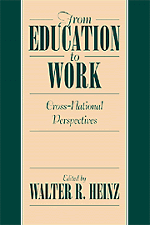Book contents
- Frontmatter
- Contents
- Contributing Authors
- Preface
- Introduction: Transitions to Employment in a Cross-National Perspective
- Part I Social Origin, Gender, and Transition Patterns
- Part II Education and Labour Markets: Work Experiences, Skills, and Credentials
- 5 Adolescent Part-Time Work and Postsecondary Transition Pathways in the United States
- 6 Multiple Life-Sphere Participation by Young Adults
- 7 The Subbaccalaureate Labor Market in the United States: Challenges for the School-to-Work Transition
- 8 Creating New Pathways to Adulthood by Adapting German Apprenticeship in the United States
- 9 Job-Entry Patterns in a Life-Course Perspective
- Part III Changes in the Social Context of Transitions
- References
- Index
6 - Multiple Life-Sphere Participation by Young Adults
Published online by Cambridge University Press: 30 September 2009
- Frontmatter
- Contents
- Contributing Authors
- Preface
- Introduction: Transitions to Employment in a Cross-National Perspective
- Part I Social Origin, Gender, and Transition Patterns
- Part II Education and Labour Markets: Work Experiences, Skills, and Credentials
- 5 Adolescent Part-Time Work and Postsecondary Transition Pathways in the United States
- 6 Multiple Life-Sphere Participation by Young Adults
- 7 The Subbaccalaureate Labor Market in the United States: Challenges for the School-to-Work Transition
- 8 Creating New Pathways to Adulthood by Adapting German Apprenticeship in the United States
- 9 Job-Entry Patterns in a Life-Course Perspective
- Part III Changes in the Social Context of Transitions
- References
- Index
Summary
Unlike previous generations, whose modal life courses had a securing and constraining nature, in which rigid institutional structures and clearly demarcated social origins and identities combined to define destinations (Beck, 1992; Levy, 1991; Zerubavel, 1981), today's youths are confronted with a variety of options and challenges as they begin the transition to adulthood. As the discourse shifts from describing individuals, lives as the extent to which they adhere to socially prescribed normative patterns (Hogan, 1978) toward a description of individuals as detraditionalized, individualized actors who live destandardized, disordered, and differentiated forms and conditions of existence (Beck, 1992; Kohli, 1986; Rindfuss, Swicegood, & Rosenfeld, 1987), the notion of a “normal biography” becomes less tenable in aiding our understanding of the courses of complex lives (Heinz, 1991a, 1996b; Marini, 1984b). It is increasingly recognized that “transition” no longer entails a simple or predetermined passage from one social institution to another and that “life courses should be understood in the light of the organization of the total social space in which our lives evolve” (Levy, 1991, p. 90). Despite the call to examine the relationships among the various roles and activities in which individuals participate, however, little empirical research has embraced this complexity.
Typically, a given transition space is conceptualized as either single institutional participation defined by a given institutional sector or as discrete sequential transitions between various sectors.
- Type
- Chapter
- Information
- From Education to WorkCross National Perspectives, pp. 149 - 170Publisher: Cambridge University PressPrint publication year: 1999
- 3
- Cited by

